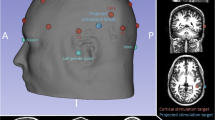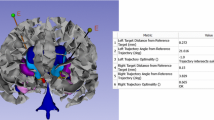Abstract
Background
Radiosurgical treatment of brain lesions near motor or language eloquent areas requires careful planning to achieve the optimal balance between effective dose prescription and preservation of function. Navigated brain stimulation (NBS) is the only non-invasive modality that allows the identification of functionally essential areas by electrical stimulation or inhibition of cortical neurons analogous to the gold-standard of intraoperative electrical mapping.
Objective
To evaluate the feasibility of NBS data integration into the radiosurgical environment, and to analyze the influence of NBS data on the radiosurgical treatment planning for lesions near or within motor or language eloquent areas of the brain.
Methods
Eleven consecutive patients with brain lesions in presumed motor or language eloquent locations eligible for radiosurgical treatment were mapped with NBS. The radiosurgical team prospectively analyzed the data transfer and classified the influence of the functional NBS information on the radiosurgical treatment planning using a standardized questionnaire.
Results
The semi-automatized data transfer to the radiosurgical planning workstation was flawless in all cases. The NBS data influenced the radiosurgical treatment planning procedure as follows: improved risk-benefit balancing in all cases, target contouring in 0 %, dose plan modification in 81.9 %, reduction of radiation dosage in 72.7 % and treatment indication in 63.7 % of the cases.
Conclusions
NBS data integration into radiosurgical treatment planning is feasible. By mapping the spatial relationship between the lesion and functionally essential areas, NBS has the potential to improve radiosurgical planning safety for eloquently located lesions.


Similar content being viewed by others
References
Andrade-Souza YM, Zadeh G, Ramani M, Scora D, Tsao MN, Schwartz ML (2005) Radiosurgery for basal ganglia, internal capsule, and thalamus arteriovenous malformation: clinical outcome. Neurosurgery 56:56–64
Antypas C, Pantelis E (2008) Performance evaluation of a CyberKnife R _ G4 image-guided robotic stereotactic radiosurgery system. Phys Med Biol 53:4697–4718
Coburger J, Musahl C, Henkes H, Horvath-Rizea D, Bittl M, Weissbach C, Hopf N (2013) Comparison of navigated transcranial magnetic stimulation and functional magnetic resonance imaging for preoperative mapping in rola ndic tumor surgery. Neurosurg Rev 36:65–76
Conti A, Pontoriero A, Ricciardi GK, Granata F, Vinci S, Angileri FF, Pergolizzi S, Alafaci C, Rizzo V, Quartarone A, Germanò A, Foroni RI, De Renzis C, Tomasello F (2013) Integration of functional neuroimaging in CyberKnife radiosurgery: feasibility and dosimetric results. Neurosurg Focus 34(4)):E5
Coulter A (2003) Patient information and shared decision-making in cancer care. Br J Cancer 89(Suppl 1):S15–16
De Witt Hamer PC, Robles SG, Zwinderman AH, Duffau H, Berger MS (2012) Impact of intraoperative stimulation brain mapping on glioma surgery outcome: a meta-analysis. J Clin Oncol 30:2559–2565
Duffau H (2013) The Dangers of Magnetic Resonance Imaging Diffusion Tensor Tractography in Brain Surgery. World Neurosurg 1. doi:10.1016/j.wneu.2013.01.116
Duffau H (2005) Lessons from brain mapping in surgery for low-grade glioma: insights into associations between tumour and brain plasticity. Lancet Neurol 4:476–486
Duffau H, Lopes M, Arthuis F, Bitar A, Sichez JP, Van Effenterre R, Capelle L (2005) Contribution of intraoperative electrical stimulations in surgery of low grade gliomas: a comparative study between two series without (1985–96) and with (1996–2003) functional mapping in the same institution. J Neurol Neurosurg Psychiatry 76:845–851
Feigl GC, Hiergeist W, Fellner C, Schebesch KMM, Doenitz C, Finkenzeller T, Brawanski A, Schlaier J (2013) MRI diffusion tensor tractography: evaluation of anatomical accuracy of different fiber tracking software packages. World Neurosurg 4. doi:10.1016/j.wneu.2013.01.004
Forster MT, Hattingen E, Senft C, Gasser T, Seifert V, Szelenyi A (2011) Navigated transcranial magnetic stimulation and functional magnetic resonance imaging: advanced adjuncts in preoperative planning for central region tumors. Neurosurgery 68:1317–1325
Frey D, Strack V, Wiener E, Jussen D, Vajkoczy P, Picht T (2012) A new approach for corticospinal tract reconstruction based on navigated transcranial stimulation and standardized fractional anisotropy values. Neuroimage 62:1600–1609
Gerosa M, Nicolato A, Foroni R, Zanotti B, Tomazzoli L, Miscusi M, Alessandrini F, Bricolo A (2002) Gamma knife radiosurgery for brain metastases: a primary therapeutic option. J Neurosurg 97(5 Suppl):515–524
Giussani C, Roux FE, Ojemann J, Sganzerla EP, Pirillo D, Papagno C (2010) Is preoperative functional magnetic resonance imaging reliable for language areas mapping in brain tumor surgery? Review of language functional magnetic resonance imaging and direct cortical stimulation correlation studies. Neurosurgery 66:113–120
Juenger H, Ressel V, Braun C, Ernemann U, Schuhmann M, Krägeloh-Mann I, Staudt M (2009) Misleading functional magnetic resonance imaging mapping of the cortical hand representation in a 4-year-old boy with an arteriovenous malformation of the central region. J Neurosurg Pediatr 4:333–338
Kamada K, Todo T, Masutani Y, Aoki S, Ino K, Takano T, Kirino T, Kawahara N, Morita A (2005) Combined use of tractography-integrated functional neuronavigation and direct fiber stimulation. J Neurosurg 102:664–672
Kawashima A, Krieg SM, Faust K, Schneider H, Vajkoczy P, Picht T (2013) Plastic reshaping of cortical language areas evaluated by navigated transcranial magnetic stimulation in a surgical case of glioblastoma multiforme. Clin Neurol Neurosurg 115(10):2226–9
Kinoshita M, Yamada K, Hashimoto N, Kato A, Izumoto S, Baba T, Maruno M, Nishimura T, Yoshimine T (2005) Fiber-tracking does not accurately estimate size of fiber bundle in pathological condition: initial neurosurgical experience using neuronavigation and subcortical white matter stimulation. Neuroimage 25:424–429
Koga T, Shin M, Maruyama K, Kamada K, Ota T, Itoh D, Kunii N, Ino K, Aoki S, Masutani Y, Igaki H, Onoe T, Saito N (2012) Integration of corticospinal tractography reduces motor complications after radiosurgery. Int J Radiat Oncol Biol Phys 83:129–133
Korvenoja A, Kirveskari E, Aronen HJ, Avikainen S, Brander A, Huttunen J, Ilmoniemi RJ, Jääskeläinen JE, Kovala T, Mäkelä JP, Salli E, Seppä M (2006) Sensorimotor cortex localization: comparison of magnetoencephalography, functional MR imaging, and intraoperative cortical mapping. Radiology 241:213–222
Krieg SM, Buchmann NH, Gempt J, Shiban E, Meyer B, Ringel F (2012) Diffusion tensor imaging fiber tracking using navigated brain stimulation—a feasibility study. Acta Neurochir (Wien) 154:555–563
Krieg SM, Shiban E, Buchmann N, Gempt J, Foerschler A, Meyer B, Ringel F (2012) b) Utility of presurgical navigated transcranial magnetic brain stimulation for the resection of tumors in eloquent motor areas. J Neurosurg 116:994–1001
Krieg SM, Shiban E, Buchmann N, Meyer B, Ringel F (2013) Presurgical navigated transcranial magnetic brain stimulation for recurrent gliomas in motor eloquent areas. Clin Neurophysiol 24:522–527
Krieg SM, Sollmann N, Hauck T, Ille S, Foerschler A, Meyer B, Ringel F (2013) Functional language shift to the right hemisphere in patients with language-eloquent brain tumors. PLoS One 17 8(9):e75403
Lioumis P, Zhdanov A, Mäkelä N, Lehtinen H, Wilenius J, Neuvonen T, Hannula H, Deletis V, Picht T, Mäkelä JP (2012) A novel approach for documenting naming errors induced by navigated transcranial magnetic stimulation. J Neurosci Methods 204:349–354
Maruyama K, Kondziolka D, Niranjan A, Flickinger JC, Lunsford LD (2004) Stereotactic radiosurgery for brainstem arteriovenous malformations: factors affecting outcome. J Neurosurg 100:407–413
Muacevic A, Kufeld M, Wowra B, Kreth FW, Tonn JC (2010) Feasibility, safety, and outcome of frameless image-guided robotic radiosurgery for brain metastases. J Neurooncol 97:267–274
Paiva WS, Fonoff ET, Marcolin MA, Cabrera HN, Teixeira MJ (2012) Cortical mapping with navigated transcranial magnetic stimulation in low-grade glioma surgery. Neuropsychiatr Dis Treat 8:197–201
Petrella JR, Shah LM, Harris KM, Friedman AH, George TM, Sampson JH, Pekala JS, Voyvodic JT (2006) Preoperative functional MR imaging localization of language and motor areas: effect on therapeutic decision making in patients with potentially resectable brain tumors. Radiology 240:793–802
Picht T, Krieg SM, Sollmann N, Rösler J, Niraula B, Neuvonen T, Savolainen P, Lioumis P, Mäkelä JP, Deletis V, Meyer B, Vajkoczy P, Ringel F (2013) A comparison of language mapping by preoperative navigated transcranial magnetic stimulation and direct cortical stimulation during awake surgery. Neurosurgery 72(808–819):2013
Picht T, Mularski S, Kuehn B, Vajkoczy P, Kombos T, Suess O (2009) Navigated transcranial magnetic stimulation for preoperative functional diagnostics in brain tumor surgery. Neurosurgery 65(6 Suppl):93–99
Picht T, Schmidt S, Brandt S, Frey D, Hannula H, Neuvonen T, Karhu J, Vajkoczy P, Suess O (2011) Preoperative functional mapping for rolandic brain tumor surgery: comparison of navigated transcranial magnetic stimulation to direct cortical stimulation. Neurosurgery 69:581–589
Picht T, Schulz J, Hanna M, Schmidt S, Suess O, Vajkoczy P (2012) Assessment of the influence of navigated transcranial magnetic stimulation on surgical planning for tumors in or near the motor cortex. Neurosurgery 70:1248–1257
Picht T, Schulz J, Vajkoczy P (2013) The preoperative use of navigated transcranial magnetic stimulation facilitates early resection of suspected low-grade gliomas in the motor cortex. Acta Neurochir (Wien) 155(10):1813–21
Pouratian N, Bookheimer SY, Rex DE, Martin NA, Toga AW (2010) The reliability of neuroanatomy as a predictor of eloquence: a review. Neurosurg Focus 28(2):E3
Robles SG, Gatignol P, Lehéricy S, Duffau H (2008) Long-term brain plasticity allowing a multistage surgical approach to World Health Organization Grade II gliomas in eloquent areas. J Neurosurg 109:615–624
Rösler J, Niraula B, Strack V, Zdunczyk A, Schilt S, Savolainen P, Lioumis P, Mäkelä J, Vajkoczy P, Frey D, Picht T (2013) Language mapping in healthy volunteers and brain tumor patients with a novel navigated TMS system: Evidence of tumor-induced plasticity. Clin Neurophysiol 125(3):526–536
Ruohonen J, Karhu J (2010) Navigated transcranial magnetic stimulation. Neurophysiol Clin 40:7–17
Rutten GJ, Ramsey NF (2010) The role of functional magnetic resonance imaging in brain surgery. Neurosurg Focus 28(2):E4
Sollmann N, Picht T, Mäkelä JP, Meyer B, Ringel F, Krieg SM (2013) Navigated transcranial magnetic stimulation for preoperative language mapping in a patient with a left fronto-opercular glioblastoma. J Neurosurg 118:175–179
Takahashi S, Jussen D, Vajkoczy P, Picht T (2012) Plastic relocation of motor cortex in a patient with LGG (low grade glioma) confirmed by NBS (navigated brain stimulation). Acta Neurochir (Wien) 154:2003–2008
Takahashi S, Vajkoczy P, Picht T (2013) Navigated transcranial magnetic stimulation for mapping the motor cortex in patients with rolandic brain tumors. Neurosurg Focus 34(5):E3
Tarapore PE, Tate MC, Findlay AM, Honma SM, Mizuiri D, Berger MS, Nagarajan SS (2012) Preoperative multimodal motor mapping: a comparison of magnetoencephalography imaging, navigated transcranial magnetic stimulation, and direct cortical stimulation. J Neurosurg 117:354–362
Tarapore PE, Findlay AM, Honma SM, Mizuiri D, Houde JF, Berger MS, Nagarajan SS (2013) Language mapping with navigated repetitive TMS: proof of technique and validation. Neuroimage 20:260–272
Tharin S, Golby A (2007) Functional brain mapping and its applications to neurosurgery. Neurosurgery 60(4 Suppl 2):185–202
Vitikainen AM, Salli E, Lioumis P, Mäkelä JP, Metsähonkala L (2013) Applicability of nTMS in locating the motor cortical representation areas in patients with epilepsy. Acta Neurochir (Wien) 155:507–518
Conflict of interest
The research reported in this article was supported in part by a grant from the Berlin Cancer Society. Dr. Picht has served as a speaker for Nexstim OY, the manufacturer of the device used in this study. Dr. Picht and Dr. Kufeld had full access to all of the data in the study and take responsibility for the integrity of the data and the accuracy of the data analysis.
Author information
Authors and Affiliations
Corresponding author
Additional information
Thomas Picht and Sarah Schilt contributed equally to this paper.
Rights and permissions
About this article
Cite this article
Picht, T., Schilt, S., Frey, D. et al. Integration of navigated brain stimulation data into radiosurgical planning: potential benefits and dangers. Acta Neurochir 156, 1125–1133 (2014). https://doi.org/10.1007/s00701-014-2079-8
Received:
Accepted:
Published:
Issue Date:
DOI: https://doi.org/10.1007/s00701-014-2079-8




